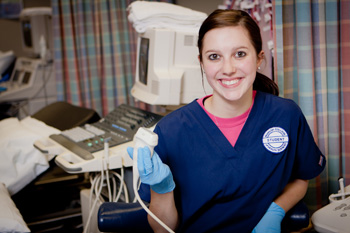Before many students become employed as a medical sonographer (aka an ultrasound technician), they often decide to extend their studies for just a little bit more time and obtain their medical sonography licensing and certification credentials. Once a student obtains certification, in addition to their associates or bachelor’s degree, they often find that obtaining interviews in a medical facility of their choice is easier. If hired, many students can look forward to a career in an industry that is growing quickly and that pays well. Medical sonographers or ultrasound technicians can make anywhere from approximately $40,000 per year to over $80,000 per year. The median income of the industry is $62,000 per year. Because the industry’s wages are significantly higher than the nation’s average wages, many people opt to join this field. Luckily, they can join this field with as little as one year of training.
 The CAAHEP (Commission on the Accreditation of Allied Health Education Programs) maintains extensive lists on which schools offer accredited programs. Currently, there are close to 200 schools that offer medical sonography licensing and certification programs. If you cannot find a school near you, you can opt to enroll in one of the three distance learning programs that the CAAHEP has certified. Only a few of these 200 programs are one-year programs. One-year programs offer the certification that is necessary to become a diagnostic songrapher, but in most cases, these programs are only relevant for people who have already had a few years of experience in the medical field.
The CAAHEP (Commission on the Accreditation of Allied Health Education Programs) maintains extensive lists on which schools offer accredited programs. Currently, there are close to 200 schools that offer medical sonography licensing and certification programs. If you cannot find a school near you, you can opt to enroll in one of the three distance learning programs that the CAAHEP has certified. Only a few of these 200 programs are one-year programs. One-year programs offer the certification that is necessary to become a diagnostic songrapher, but in most cases, these programs are only relevant for people who have already had a few years of experience in the medical field.
The vast majority of people who are interested in working in the sonography field pursue two-year associates degrees. These degrees include classes on medical ethics, elementary physics, anatomy, physiology, and how to work the equipment. It is also possible to get a four-year degree to work in this field. The four-year bachelor’s degree focuses on much of the same information that is covered in the two-year degree. However, as it is a bachelor’s degree, it also requires its students to complete several general courses.
Once a person has completed their degree, they can become professionally certified. Although no states currently require certification, it is a useful professional tool that can help a person get a job. There are three different certifying bodies. The American Registry for Diagnostic Medical Sonography requires interested parties to take an exam. After they pass the exam, they are registered as a Registered Diagnostic Medical Sonographer. This credential can be applied for three different specialty areas including the abdomen, the breasts, or the nervous system. If someone wants to become certified in breast or vascular sonography, they should get certified through the The American Registry of Radiologic Technologists. If someone wants to work as a cardiac sonographer, they should gain their credentials through Cardiovascular Credentialing International. Obtaining any one of these three medical sonography certification credentials makes a person very employable in the medical diagnostic sonography field.